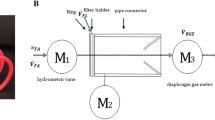Summary
A six-stage Andersens's sampler was compared with a single stage type (SAS) for the collection of airborne fungi particles.
The efficiency of two non selective culture media, and namely malt agar (MA) and potato dextrose agar (PDA), which were both modified in order to inhibit bacterial growth, was compared as well.
An overall assessment of quantitative results suggests that the two samplers have a comparable degree of efficiency. However, the SAS appears to collect a greater number of CFU/m3 in absence of wind and viceversa the Andersen one appears to be more efficient in the presence of wind.
The number of species detected with the SAS device is smaller, thus requiring an increased number of suctions.
Andersen sampler sieving, according to the aerodynamic characteristics of the particles, appears to be not too accurate: there is an overlap from stage to stage of the sampler and some larger particles settle on smaller particle-collecting stages and viceversa.
The PDA, with streptomycin and chloramphenicol, is better and closer to the natural distribution pattern: the number of CFU/m3 is higher although the number of the collected species is about the same.
Similar content being viewed by others
References
Al-Doory Y., (1970) —Application of Andersen sampler in studying airborne fungi in San Antonio (Texas). Mycopath. Mycol. Appl.,42:293–298.
Al-Doory Y., (1984) —Airborne fungi. In Al-Doory Y. and Domson J.F.,Mould Allergy, Sea & Febiger, Philadelphia.
Al-Doory Y., Domson J.F., Best J., (1982) —Further studies of the airborne fungi and pollens of the Washington D.C. metropolitan area. Ann. Allergy,49:265–269.
Andersen A.A., (1958) —New sampler for the collection, sizing and enumeration of viable airborne particles. J. Bact.,76:471–484.
Beaumont F., Kauffman H.F., Vandermark T.H., Sluiter H.J., De Vries K., (1985) —Volumetric aerobiological survey of conidial fungi in the North East Netherlands. Allergy,40:173–180.
Blomquist G., Strom G., Stromquist L.H., (1984a) —Sampling of hight concentrations of airborne fungi. Scand. J. Work Environ. Health.,10:109–113.
Blomquist G., Palmgren U., Strom G., (1985b) —Improved tecniches for sampling airborne fungal particles in highly contaminated environments. Scand. J. Work Environ. Health,10:253–258.
Burge H.P., Solomon W.R., Boise J.R., (1977) —Comparative merits of eight popular media in aerometric studies of fungi. J. Allergy Clin. Immunol., 60:199–203.
Caretta G., Piontelli E., Del Frate G., Crippa A., Savini L., Todaro F., (1975) —Spore fungine dell'atmosfera urbana di Pavia: risultati ottenuti con il metodo di esposizione delle piastre. Riv. Patol. Veg.,11:5–23.
D'Amato G., (1981) —Allergia respiratoria da pollini e da miceti. Lombardo Ed: Roma.
Edmonds R.L., (1979) —Aerobiology: the Ecological System Approach. Dowden, Hutchinson & Ross, Inc., Stroudsburg.
Fradkin A., (1987) —Sampling of microbiological contaminants in indoor air. In Taylor J.K.Sampling and calibration for atmospheric measurements. ASTM, STP 957, J.K. Taylor: 66–77.
Fradkin A., Tobin R.S., Tarlo S.M., Tucic-Porretta M. Malloch D., (1987) —Species identification of airborne molds and its significance for the detection of indoor pollution. J. Apca,378:51–53.
Gregory P.H., (1973) —The microbiology of the atmosphere. John Wiley & Sons, New York.
Gullino M.L., Garibaldi A., (1982) —Risultati di un'indagine effettuata per verificare la presenza di ceppi di Botrytis cinereaPers. resistenti ai benzimidazolici e ai dicarbossimidici nei vigneti italiani. Notiz. Mal. Piante,103:145–150.
Gullino M.L. Romano M.L., (1984) —Resistenza in Botrytis cinereaPers. ai fungicidi dicarbossimidici: situazione attuale nei vigneti italiani. Noitz. Mal. Piante,104:103–110.
Gullino M.L., Garibaldi A., (1985) —Present situation of resistence to fungicide in italian vinegards. BCPC Monograph31:319–322.
Hirsch S.R., Sosman J.A., (1976) —A one-year survey of mold growth inside 12 homes. Ann. Allergy,36:30–38.
Hudson H.J., (1969) —Aspergilli in the air spora at Cambridge. Trans. Br. Mycol. Soc.,52:153–159.
Ingold C.T., (1965) —Spore liberation. Clavendon Press, Oxford.
Hirst J.M., Stedman O.J., (1963) —Dry liberation of fungus spores by raindrops. J. Gen. Microbiol.,33:335–344.
Hyde H.A., (1973) —Atmosphere pollen and spores in relation to allergy. Clin. Allergy,3:109–126.
Kramer C.L., Pady S.M., Wiley B.J., (1963) —Kansas aeromycology. XIII: diurnal studies 1959–1960. Mycologia,55:380–400.
Lacey J., (1981) —The aerobiology of conidial fungi. In Cole G.T. and Kendrick B.Biology of conidial fungi. Academic Press, New York, pp. 373–416.
Lach V., (1985) —Performance of the surface air system air samplers. J. Hosp. inf.,6:102–107.
Levetin E., Hurewitz D., (1978) —A one-year survey of the airborne molds of Tulsa, Oklahoma. II. Indoor survey. Ann. Allergy,41:21–24.
Mullins J., Hutcheson P.S., Slavin R.G., (1984) — Aspergillus fumigatusspore concentration in outside air: Cardiff and St. Louis compared. Clin. Allergy,14:351–354.
Nolard-Tintigner N., Snoeck R., Leleux A., Beguin H., Moolens F., Meunier-Carpentier F., (1985) —Mise en evidence d'Aspergillus fumigatuslors de travaux de construction et de renovation en milieu hospitalier. Bull. Soc. Fr. Mycol. Med.,14:93–98.
Pisano P.L., Palmas F., Cardia P., Falqui A., Ligia G.P., Mereu S., (1984) —Le aerospore fungine in ambiente di lavoro agricolo in Sardegna. Folia Allergol. Immunol. Clin.,31:227–234.
Rippon J.W., (1982) —Medical Mycology. Pathogenic Fungi and the Pathogenic Actinomycetes W.B. Saunders Comp, Philadelphia.
Sheridan J.E., Coleman E.D., Holst P.E., O'Donnel T.V., (1983) —Aeroallergens in the homes of Wellington asthmatics. I. Settle plate survey for viable fungi. N.Z.J.Sci.,26:1–7.
Solomon W.R., Burge H.P., (1975) — Aspergillus fumigatuslevels in and out-of-doors in urban air. J. Allergy Clin. Immunol.,55:90–91.
Solomon W.R., Burge H.P., Boise J.R., (1978) —Airborne Aspergillus fumigatuslevels outside and within a large clinical center. J. Allergy Clin. Immunol.,62:56–60.
Strom G., Blomquist G., (1986) —Airborne spores from mouldy citrus fruit: a potential occupational health hazard. Ann. Occup. Hyg.,30:455–460.
Vittal B.P.R., Glory A.L., (1985) —Airborne fungus spores of a library in India. Grana,24:129–132.
Wiley B.J., Hebert R.L., Armstrong J., Kaplan A.M., (1982) —The aerobiology of an environmental test chamber. Mycologia,74:886–893.
Author information
Authors and Affiliations
Rights and permissions
About this article
Cite this article
Marchisio, V.F., Caramiello, R. & Mariuzza, L. Outdoor airborne fungi: sampling strategies. Aerobiologia 5, 145–153 (1989). https://doi.org/10.1007/BF02486512
Issue Date:
DOI: https://doi.org/10.1007/BF02486512




